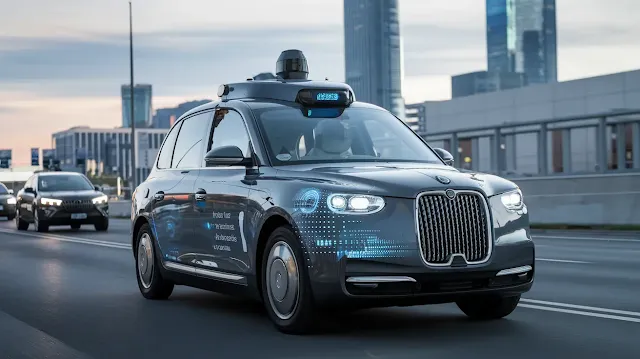Self-Driving Taxis: A Revolution in Urban Transportation
Self-driving taxis represent a groundbreaking leap in technology and urban mobility. Powered by artificial intelligence, advanced sensors, and machine learning algorithms, these vehicles promise to transform transportation by offering safer, more efficient, and sustainable travel options.
Introduction: The Evolution of Autonomous Taxis
Autonomous taxis, also known as self-driving taxis, are set to redefine urban transportation. By reducing accidents caused by human error, enhancing fuel efficiency, and promoting sustainable mobility, these innovative vehicles aim to address some of the most pressing challenges in modern transit.
The Cutting-Edge Technology Behind Self-Driving Taxis
Artificial Intelligence (AI): The Brain of Autonomous Vehicles
AI serves as the foundation of self-driving cars, processing vast amounts of data in real-time to make intelligent decisions on the road. Through continuous learning, AI enables these vehicles to adapt and improve over time.
Advanced Sensing Systems: Enhancing Perception and Navigation
- Radar: Detects distances and identifies objects, enabling the vehicle to maintain safe positioning and avoid collisions.
- Lidar (Light Detection and Ranging): Utilizes laser beams to create precise 3D maps of the environment, ensuring accurate object detection.
- Cameras: Provide visual inputs, helping the vehicle recognize traffic signals, pedestrians, and other vehicles.
Machine Learning: Predicting and Adapting to Traffic Behavior
Self-driving cars rely on machine learning algorithms to analyze patterns, and predict the actions of other road users, allowing for improved performance, and safety in dynamic traffic conditions.
Key Benefits of Self-Driving Taxis
Improved Safety: Reducing Human Error
- Fewer Accidents: Advanced sensors and AI minimize risks associated with fatigue, distractions, and impaired driving.
- Rapid Responses: Autonomous systems react swiftly to sudden road changes, such as unexpected pedestrian crossings.
- Eliminating Risky Behavior: These vehicles operate without engaging in dangerous practices like speeding or reckless overtaking.
Enhanced Efficiency: Transforming Urban Mobility
- Optimized Traffic Flow: Self-driving cars communicate with each other and traffic systems to reduce congestion.
- Integrated Transportation: Seamless connections with public transit, such as buses and trains, streamline commutes.
- Faster Parking: Autonomous vehicles quickly locate parking spaces, saving time and reducing stress.
Sustainability: Driving Towards a Greener Future
- Fuel Efficiency: AI-driven optimization reduces unnecessary acceleration and braking, conserving fuel.
- Lower Emissions: By improving efficiency, self-driving cars contribute to reduced carbon footprints.
- Electric Integration: Many companies focus on developing electric self-driving vehicles, powered by renewable energy for environmental sustainability.
Challenges Hindering the Adoption of Self-Driving Taxis
Technological Hurdles
- Complex Systems: The sophisticated technology behind autonomous taxis requires meticulous maintenance and constant updates.
- Data Management: Managing and processing vast amounts of data demands robust infrastructure.
- Environmental Limitations: Adverse weather, and evolving cityscapes pose challenges for accurate object detection.
Regulatory Barriers
- Lack of Clear Policies: Many regions still lack comprehensive laws to regulate self-driving vehicles.
- Liability Concerns: Determining responsibility in accidents involving autonomous taxis remains a legal gray area.
- Permitting Issues: Securing operational licenses for these vehicles involves navigating intricate regulatory processes.
Societal Resistance
- Trust Issues: Gaining public confidence in autonomous technology is crucial for widespread acceptance.
- Adaptation Challenges: Communities need time and education to embrace the changes brought by self-driving taxis.
- Job Displacement: Traditional taxi drivers may face unemployment, necessitating workforce reskilling initiatives.
Industry Leaders and Real-World Applications
Waymo: Pioneering Autonomous Mobility
A subsidiary of Google, Waymo has conducted successful self-driving trials in several U.S. cities, establishing itself as a leader in the field.
Tesla: Innovating Towards Full Autonomy
Tesla’s vehicles incorporate advanced self-driving features, with continuous updates aimed at achieving full automation.
Uber: Exploring Autonomous Ride-Hailing
Uber has launched pilot programs for self-driving taxis, focusing on enhancing urban transportation in major cities.
Conclusion: Navigating the Road Ahead
Self-driving taxis hold immense potential to revolutionize urban mobility, offering safer, more efficient, and environmentally friendly travel options. However, addressing technological, legal, and societal challenges is crucial for unlocking their full benefits. By overcoming these obstacles, autonomous taxis can pave the way for a smarter, and more sustainable future in transportation.


